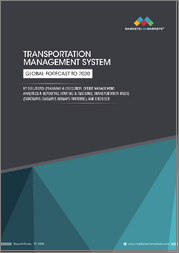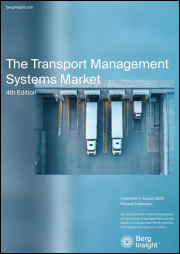
|
시장보고서
상품코드
1604463
운송 관리 시스템 시장 : 구성요소별, 전개 방식별, 기업 규모별, 고객 유형별, 운송 모드별, 최종사용자 산업별, 지역별, 기회, 예측(2017-2031년)Transportation Management System Market Assessment, By Component, By Deployment Mode, By Company Size, By Customer Type, By Transportation Mode, By End-user Industry, By Region, Opportunities and Forecast, 2017-2031F |
||||||
세계 운송 관리 시스템 시장 규모는 2024-2031년 예측 기간 동안 15.85%의 CAGR로 2023년 109억 7,000만 달러에서 2031년 355억 9,000만 달러로 확대될 것으로 예상됩니다.
E-Commerce 매출이 급격히 증가하여 운송 관리 시스템(TMS) 시장의 성장을 주도하고 있습니다. 국제무역협회에 따르면 2026년 세계 기업 간 E-Commerce 부문 매출은 36조 달러에 달할 것으로 예상되며, 세계 상품 운송 수요 증가로 인해 2027년까지 세계 기업 대 고객 매출은 5조 5,000억 달러에 달할 것으로 예상됩니다. 또한 아시아태평양은 기업 간 E-Commerce 시장의 80%를 차지할 것으로 예상되며 라틴아메리카와 중동의 급속한 성장은 경쟁력있는 운송 관리 시스템 도구의 필요성을 더욱 강조합니다.
또한, 온라인 쇼핑의 증가로 인해 더 나은 배송 추적과 빠른 주문 처리 옵션에 대한 수요가 증가하고 있습니다. 그 결과, BtoB 기업의 90% 이상이 가상 판매 전략을 도입하고 지속적인 실시간 물류를 우선순위에 두고 있습니다. 이러한 E-Commerce의 증가는 대규모의 복잡한 배송을 관리할 수 있는 효율적이고 강력한 운송 관리 시스템을 필요로 합니다.
예를 들어, 2024년 1월 Kinaxis Inc.는 공급망 가시성, 수요 예측 및 보충 계획을 강화하기 위해 AI와 ML을 활용한 운송 관리 시스템의 진화를 발표했습니다. 이 혁신은 소매업체가 복잡한 공급망을 관리하고 운영 효율성을 향상시킬 수 있도록 돕기 위해 고안되었습니다.
이 보고서는 세계 운송 관리 시스템 시장을 조사하여 시장 개요와 함께 구성요소별, 전개 방식별, 기업 규모별, 고객 유형별, 운송 모드별, 최종사용자 산업별, 지역별 동향, 시장 진입 기업 개요 등을 제공합니다.
목차
제1장 프로젝트 범위와 정의
제2장 조사 방법
제3장 주요 요약
제4장 고객의 소리
제5장 세계의 운송 관리 시스템 시장 전망, 2017-2031년
- 시장 규모 분석과 예측
- 시장 점유율 분석과 예측
- 시장 맵 분석, 2023년
- 구성요소별
- 전개 방식별
- 기업 규모별
- 고객 유형별
- 운송 수단별
- 최종 이용 업계별
- 지역별
제6장 북미의 운송 관리 시스템 시장 전망, 2017-2031년
제7장 유럽의 운송 관리 시스템 시장 전망, 2017-2031년
제8장 아시아태평양의 운송 관리 시스템 시장 전망, 2017-2031년
제9장 남미의 운송 관리 시스템 시장 전망, 2017-2031년
제10장 중동 및 아프리카의 운송 관리 시스템 시장 전망, 2017-2031년
제11장 밸류체인 분석
제12장 Porter's Five Forces 분석
제13장 PESTLE 분석
제14장 시장 역학
제15장 시장 동향과 발전
제16장 사례 연구
제17장 경쟁 상황
- 시장 리더 탑 5 경쟁 매트릭스
- 진출 기업 탑 5 SWOT 분석
- 시장 진출 기업 탑 10 상황
- Blue Yonder, Inc.
- C.H. Robinson Worldwide, Inc.
- Descartes Systems Group Inc.
- E2open, LLC
- Kinaxis Inc.
- Manhattan Associates, Inc.
- MercuryGate International, Inc.
- Oracle Corporation
- SAP SE
- Trimble Inc.
제18장 전략적 제안
제19장 문의와 면책사항
ksm 24.12.12Global transportation management system market is projected to witness a CAGR of 15.85% during the forecast period 2024-2031, growing from USD 10.97 billion in 2023 to USD 35.59 billion in 2031.
E-commerce sales have dramatically increased, resulting in the growth of the transportation management system (TMS) market. According to the International Trade Administration, the value of the global business-to-business e-commerce sector is expected to reach USD 36 trillion in 2026, and global business-to-customer sales are poised to reach USD 5.5 trillion by 2027 owing to increasing demand for the transportation of goods across the globe. Also, the Asia-Pacific region is likely to account for 80% of the business-to-business e-commerce market, and the rapid growth in Latin America and the Middle East further emphasizes the necessity for competitive transportation management system tools.
Moreover, the rise in online shopping drives demand for better delivery tracking and quick fulfillment options. As a result, more than 90% of business-to-business companies started to incorporate virtual sales strategies and prioritize continuous and real-time logistics. This increase in e-commerce requires an efficient and powerful transportation management system to manage large-scale complex shipments.
For instance, in January 2024, Kinaxis Inc. unveiled AI and ML-powered advancements in its transportation management system to enhance supply chain visibility, demand forecasting, and replenishment planning. The innovations are designed to help retailers manage complex supply chains and improve operational efficiency.
Surge in Cloud Adoption Drives Transportation Management System Market
Cloud deployment majorly influences the transportation management system (TMS) market, as global spending on cloud infrastructure is expected to increase during the forecast period. Businesses are increasingly drawn to transportation management system software as a service solution hosted in the cloud. Cloud adoption in transportation management systems provides better real-time data and analytics through seamless integrations. This improves route optimization, delivery tracking, and the supply chain, influencing the development of transportation management systems with greater investments from hyper-scalers into AI, allowing for smarter and more predictive logistics solutions. According to Intel Corporation, software as a service (SaaS) and cloud services are emerging as the top choices for new applications, rising from 77% in 2022 to 91% in 2023. Furthermore, investments from hyper-scalers into AI technologies will continue to support the development of advanced delivery and return options, providing businesses with streamlined operations and enhancing their competitive edge in the logistics sector.
For example, in June 2024, E2open, LLC introduced the Scheduling Standards Consortium (SSC) Appointment Scheduling API within its Transportation Management solution. This new API aims to streamline dock scheduling, reduce manual work, and improve collaboration among supply chain partners.
Enhanced Supply Chain Visibility Transforms the Transportation Management System Market
The ongoing trend of improving supply chain visibility is expected to continue driving growth in the transportation management system market, even as achieving complete visibility remains a challenge for businesses. Ocean freight is noted for providing the least real-time visibility, whereas roadway operations offer superior visibility. Real-time tracking and route optimization are identified as the most critical capabilities for enhancing supply chain visibility. As a result, businesses are increasingly adopting modern transportation management system solutions to gain better control over factors such as traffic and weather information. Furthermore, automated fleet planning technologies and advanced driver assistance systems (ADAS) are used to enhance route efficiency and fuel optimization. This heightened focus on visibility and efficiency is driving the popularity of powerful transportation management system solutions.
For example, in April 2024, E2open, LLC launched Supply Network Discovery, enhancing supply chain visibility and compliance. Unveiled at Connect Europe 2024, this tool helps clients identify sub-tier suppliers and manage regulatory risks effectively.
Government Initiatives Act as a Catalyst
Leading vendors in the transportation management system (TMS) market benefit from government initiatives aimed at technological advancement and infrastructural improvements. The United States Infrastructure Investment and Jobs Act provides allocation of funds for smart transportation systems, enhancing the capabilities of transportation management system, and supporting intelligent transportation systems through funding from the new Horizon Europe Program, which aids in transportation management system (TMS) innovation. Furthermore, Canada's National Trade Corridors Fund invests in infrastructure projects that incorporate smart transportation technologies, further supporting the growth of the TMS market.
For instance, in March 2021, China introduced its 14th Five-Year Plan for National Economic and Social Development and Vision 2035, emphasizing substantial investments in transportation infrastructure. The plan aims to boost logistics efficiency and integrate advanced technologies into transportation management systems to drive national progress.
Roadways Sector Leads the Transportation Management System Market
The roadways segment is leading the growth in the transportation management system market, evidenced by a 6.6% increase in road freight volume in the United States. This demonstrates the dominance of roadways in logistics, owing to the flexibility and efficiency of cargo movement. Compared to other modes of transport, the stability and expansion of the road freight segment are driving the adoption of advanced transportation management system solutions. These solutions enhance route optimization and real-time tracking, highlighting the critical importance of roadways in improving efficiency within transportation management systems.
North America Dominates the Transportation Management System Market Share
North America dominates the transportation management system (TMS) market owing to its strong demand for competent supply chain solutions and advanced logistics infrastructure. North America's robust growth in e-commerce and manufacturing sectors has increased the need for better transportation management systems to optimize transportation and costs. Prominent players in North America have adopted advanced technologies like AI, IoT, and blockchain at the early stage, which enhance transportation management system capabilities to gain a competitive edge in the market. Additionally, supportive government initiatives, such as the U.S. Infrastructure Investment and Jobs Act, further boost investment in smart transportation systems, solidifying North America's global transportation management system market leadership.
For instance, in September 2023, C.H. Robinson Worldwide, Inc. opened a 400,000 sq. ft. cross-border logistics facility in Texas, expanding its footprint to 1.5 million sq. ft. This facility enhances trade efficiency amid growing nearshoring trends along the Mexico border.
Future Market Scenario (2024-2031F)
Transportation management system platforms will leverage adaptive intelligence, providing accurate predictions for transit times and identifying at-risk shipments, enhancing decision-making.
Blockchain technology will ensure transparency and security across supply chains, enabling intelligent track-and-trace systems that boost trust and efficiency.
Advanced cold chain management will monitor temperature-sensitive shipments, ensuring compliance and product integrity from origin to destination.
The transportation management system will integrate global trade management systems to navigate complex regulations, ensuring compliance while maintaining delivery speed and accuracy.
Key Players Landscape and Outlook
The increasing emphasis on sustainability and green logistics is prompting vendors to incorporate eco-friendly features into transportation management systems. This will involve the optimization of routes to reduce fuel consumption and associated carbon emissions while increasing energy efficiency. With tightening environmental regulations and rising consumer desire for sustainable products, companies are shifting to transportation management system solutions that reinforce their corporate sustainability ambitions. It helps them to comply with regulations and improve their brand image and competitiveness in the market, which boosts the further growth of the transportation management system market.
In August 2024, Blue Yonder Group, Inc. completed its acquisition of One Network Enterprises, Inc. for approximately USD 839 million. This acquisition strengthens Blue Yonder's digital supply chain capabilities, enabling real-time collaboration and data sharing across supply chain partners for enhanced business agility.
In November 2023, Aptean, Inc. acquired 3T Logistics & Technology Group Ltd., a UK-based provider of cloud-based transportation management systems. This acquisition enhances Aptean's TMS offerings in Europe, introducing 3T's EVENT platform to optimize logistics and improve operational efficiency for shippers and carriers.
Table of Contents
1. Project Scope and Definitions
2. Research Methodology
3. Executive Summary
4. Voice of Customer
- 4.1. Product and Market Intelligence
- 4.2. Mode of Brand Awareness
- 4.3. Factors Considered in Purchase Decisions
- 4.3.1. Features and Other Value-Added Service
- 4.3.2. IT Infrastructure Compatibility
- 4.3.3. Efficiency of Solutions
- 4.3.4. After-Sales Support
- 4.4. Consideration of Privacy and Regulations
5. Global Transportation Management System Market Outlook, 2017-2031F
- 5.1. Market Size Analysis & Forecast
- 5.1.1. By Value
- 5.2. Market Share Analysis & Forecast
- 5.2.1. By Component
- 5.2.1.1. Hardware
- 5.2.1.2. Software
- 5.2.1.3. Services
- 5.2.2. By Deployment Mode
- 5.2.2.1. On-Premises
- 5.2.2.2. Cloud-Based
- 5.2.2.3. Hybrid
- 5.2.3. By Company Size
- 5.2.3.1. Large Enterprises (> 1000 Employees)
- 5.2.3.2. Small and Medium-Sized Enterprises (SMEs) (< 1000 Employees)
- 5.2.4. By Customer Type
- 5.2.4.1. Business to Business (B2B)
- 5.2.4.2. Business to Customer (B2C)
- 5.2.4.3. Direct to Consumer (D2C)
- 5.2.5. By Transportation Mode
- 5.2.5.1. Roadways
- 5.2.5.2. Railways
- 5.2.5.3. Airways
- 5.2.5.4. Maritime
- 5.2.6. By End-user Industry
- 5.2.6.1. Retail and E-Commerce
- 5.2.6.2. Manufacturing
- 5.2.6.2.1. Automotive
- 5.2.6.2.2. Electronics
- 5.2.6.2.3. Pharmaceuticals
- 5.2.6.2.4. Consumer Goods
- 5.2.6.3. Logistics and Transportation
- 5.2.6.4. Energy and Utilities
- 5.2.6.5. Government and Defense
- 5.2.6.6. Others
- 5.2.7. By Region
- 5.2.7.1. North America
- 5.2.7.2. Europe
- 5.2.7.3. Asia-Pacific
- 5.2.7.4. South America
- 5.2.7.5. Middle East and Africa
- 5.2.8. By Company Market Share Analysis (Top 5 Companies and Others - By Value, 2023)
- 5.2.1. By Component
- 5.3. Market Map Analysis, 2023
- 5.3.1. By Component
- 5.3.2. By Deployment Mode
- 5.3.3. By Company Size
- 5.3.4. By Transportation Mode
- 5.3.5. By End-user Industry
- 5.3.6. By Region
6. North America Transportation Management System Market Outlook, 2017-2031F*
- 6.1. Market Size Analysis & Forecast
- 6.1.1. By Value
- 6.2. Market Share Analysis & Forecast
- 6.2.1. By Component
- 6.2.1.1. Hardware
- 6.2.1.2. Software
- 6.2.1.3. Services
- 6.2.2. By Deployment Mode
- 6.2.2.1. On-Premises
- 6.2.2.2. Cloud-Based
- 6.2.2.3. Hybrid
- 6.2.3. By Company Size
- 6.2.3.1. Large Enterprises (> 1000 Employees)
- 6.2.3.2. Small and Medium-Sized Enterprises (SMEs) (< 1000 Employees)
- 6.2.4. By Customer Type
- 6.2.4.1. Business to Business (B2B)
- 6.2.4.2. Business to Customer (B2C)
- 6.2.4.3. Direct to Consumer (D2C)
- 6.2.5. By Transportation Mode
- 6.2.5.1. Roadways
- 6.2.5.2. Railways
- 6.2.5.3. Airways
- 6.2.5.4. Maritime
- 6.2.6. By End-user Industry
- 6.2.6.1. Retail and E-Commerce
- 6.2.6.2. Manufacturing
- 6.2.6.2.1. Automotive
- 6.2.6.2.2. Electronics
- 6.2.6.2.3. Pharmaceuticals
- 6.2.6.2.4. Consumer Goods
- 6.2.6.3. Logistics and Transportation
- 6.2.6.4. Energy and Utilities
- 6.2.6.5. Government and Defense
- 6.2.6.6. Others
- 6.2.7. By Country Share
- 6.2.7.1. United States
- 6.2.7.2. Canada
- 6.2.7.3. Mexico
- 6.2.1. By Component
- 6.3. Country Market Assessment
- 6.3.1. United States Transportation Management System Market Outlook, 2017-2031F*
- 6.3.1.1. Market Size Analysis & Forecast
- 6.3.1.1.1. By Value
- 6.3.1.2. Market Share Analysis & Forecast
- 6.3.1.2.1. By Component
- 6.3.1.2.1.1. Hardware
- 6.3.1.2.1.2. Software
- 6.3.1.2.1.3. Services
- 6.3.1.2.2. By Deployment Mode
- 6.3.1.2.2.1. On-Premises
- 6.3.1.2.2.2. Cloud-Based
- 6.3.1.2.2.3. Hybrid
- 6.3.1.2.3. By Company Size
- 6.3.1.2.3.1. Large Enterprises (> 1000 Employees)
- 6.3.1.2.3.2. Small and Medium-Sized Enterprises (SMEs) (< 1000 Employees)
- 6.3.1.2.4. By Customer Type
- 6.3.1.2.4.1. Business to Business (B2B)
- 6.3.1.2.4.2. Business to Customer (B2C)
- 6.3.1.2.4.3. Direct to Consumer (D2C)
- 6.3.1.2.5. By Transportation Mode
- 6.3.1.2.5.1. Roadways
- 6.3.1.2.5.2. Railways
- 6.3.1.2.5.3. Airways
- 6.3.1.2.5.4. Maritime
- 6.3.1.2.6. By End-user Industry
- 6.3.1.2.6.1. Retail and E-Commerce
- 6.3.1.2.6.2. Manufacturing
- 6.3.1.2.6.2.1. Automotive
- 6.3.1.2.6.2.2. Electronics
- 6.3.1.2.6.2.3. Pharmaceuticals
- 6.3.1.2.6.2.4. Consumer Goods
- 6.3.1.2.6.3. Logistics and Transportation
- 6.3.1.2.6.4. Energy and Utilities
- 6.3.1.2.6.5. Government and Defense
- 6.3.1.2.6.6. Others
- 6.3.1.2.1. By Component
- 6.3.1.1. Market Size Analysis & Forecast
- 6.3.2. Canada
- 6.3.3. Mexico
- 6.3.1. United States Transportation Management System Market Outlook, 2017-2031F*
All segments will be provided for all regions and countries covered
7. Europe Transportation Management System Market Outlook, 2017-2031F
- 7.1. Germany
- 7.2. France
- 7.3. Italy
- 7.4. United Kingdom
- 7.5. Russia
- 7.6. Netherlands
- 7.7. Spain
- 7.8. Turkey
- 7.9. Poland
8. Asia-Pacific Transportation Management System Market Outlook, 2017-2031F
- 8.1. India
- 8.2. China
- 8.3. Japan
- 8.4. Australia
- 8.5. Vietnam
- 8.6. South Korea
- 8.7. Indonesia
- 8.8. Philippines
9. South America Transportation Management System Market Outlook, 2017-2031F
- 9.1. Brazil
- 9.2. Argentina
10. Middle East and Africa Transportation Management System Market Outlook, 2017-2031F
- 10.1. Saudi Arabia
- 10.2. UAE
- 10.3. South Africa
11. Value Chain Analysis
12. Porter's Five Forces Analysis
13. PESTLE Analysis
14. Market Dynamics
- 14.1. Market Drivers
- 14.2. Market Challenges
15. Market Trends and Developments
16. Case Studies
17. Competitive Landscape
- 17.1. Competition Matrix of Top 5 Market Leaders
- 17.2. SWOT Analysis for Top 5 Players
- 17.3. Key Players Landscape for Top 10 Market Players
- 17.3.1. Blue Yonder, Inc.
- 17.3.1.1. Company Details
- 17.3.1.2. Key Management Personnel
- 17.3.1.3. Products and Services
- 17.3.1.4. Financials (As Reported)
- 17.3.1.5. Key Market Focus and Geographical Presence
- 17.3.1.6. Recent Developments/Collaborations/Partnerships/Mergers and Acquisitions
- 17.3.2. C.H. Robinson Worldwide, Inc.
- 17.3.3. Descartes Systems Group Inc.
- 17.3.4. E2open, LLC
- 17.3.5. Kinaxis Inc.
- 17.3.6. Manhattan Associates, Inc.
- 17.3.7. MercuryGate International, Inc.
- 17.3.8. Oracle Corporation
- 17.3.9. SAP SE
- 17.3.10. Trimble Inc.
- 17.3.1. Blue Yonder, Inc.
Companies mentioned above DO NOT hold any order as per market share and can be changed as per information available during research work.



















